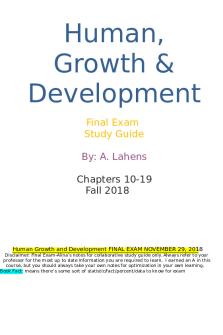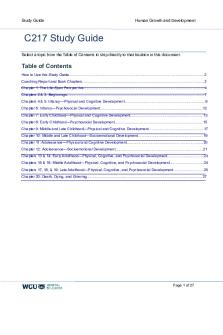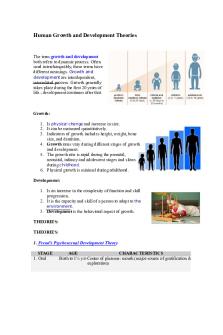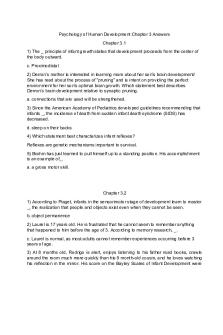Psychology of Human Growth and Development Exam 1 Study Guide PDF

| Title | Psychology of Human Growth and Development Exam 1 Study Guide |
|---|---|
| Course | Psychology of Human Growth and Development |
| Institution | Appalachian State University |
| Pages | 14 |
| File Size | 256.5 KB |
| File Type | |
| Total Downloads | 67 |
| Total Views | 160 |
Summary
spring...
Description
Human Growth and Development Exam One: Feb 9 Chapter 1: History Definitional Issues: Lifespan Human Development: Conception until death, covers changes both positive and negative as well as things that are stable and stay the same (ex. Personality). Periods of Development o Prenatal: only stage with 2 biological boundaries (starts with conception and ends with birth) o Infancy (Birth-2 yrs) Starts with walking and ends with talking Neonate (0-30 days) Toddler (Walking- 2 yrs) starts with walking and ends with talking o Early Childhood (2-6 yrs) Starts with talking and ends with socialization education o Middle Childhood (6-11 yrs) Elementary school age o Adolescence (~12-19 yrs) o Emerging Adulthood (~19-25 yrs) Not everyone agrees on this stage all other stages are universal except for this one o Early Adulthood (~25-40/45 yrs) o Middle Adulthood (40/45-60/65 yrs) Physical changes begin, hit career peak, kids begin to leave or are already gone o Late Adulthood (60/65 yrs-Death) Increase in lifespan around the world Domains of Development o Physical: Brain, physical, vision, growth, etc. o Cognitive: Thinking processes, memory, learning, problem solving, talking, etc. o Social: Relationships with other people, attachment o Emotional: Anger, guilt, envy, happiness and the development of these. Contexts of Development o Ecological Systems Theory-Bronfenbrenner: proposes series of systems that interact with one another. Individual is in center o Microsystem: Family, friends, team, workplace o Mesosystem: Connects microsystems together (ex: parent teacher conferences, homework) o Exosystem: School, community, support, agencies such as police department/firefighters o Macrosystem: encompass all the other things, politics, countries, laws, UN, culture, religion, etc. o Chronosystem: time
** dynamic reciprocal influence: influence goes both ways at all levels Timing of Events Age-Graded Influences: things people are expected to do at a certain age. Differs across cultures, history, time periods, etc. Example is you are expected to get married in your 20’s History-Graded Influences: Big historical or natural disaster events that everyone goes through. Example is 9/11, hurricane Katrina, etc. Non-normative Influences: Events are not expected or not expected to happen when it does, for example your house burning down, or your parents dying when you are a child (vs them dying when you are middle aged) Cultural Context Cohort: people around the same age as you and those who experience same history graded events at the time (cohort is considered to be around ~10 years) Ethnic Group: Groups of people with the same values, morals, religion, etc. Socioeconomic Status (SES): related to how much money you make, there are three factors that make up SES o Occupation o Where you live o Education level Basic Theoretical Issues: Nature vs. Nurture o Nature means genetics, biochemical o Nurture is the environment and how you are raised. Continuity vs. Discontinuity o Continuity is slow smooth and graduate development o Discontinuity is development in abrupt stages World Views: Not everybody agrees how the world works, also called metaviews or theories about theories o Mechanism: mechanists see the world as machine like, and only operate when turned on. Sees the person as relatively plain unless the environment acts on it (Skinner was a mechanist) o Organicism: Thinks organism is really active, environment is there but only has impact when you interact with it (Piaget) o Contextualism: Think nature/nurture are intertwined. Our biology is changed by what we and others do, focuses on unpredictability (Bronfenbrenner and Vygotsky) Deficit vs. Difference: putting a value on something that is different between people (Carol Gilligan and the child’s play study)
Classic Theories o Freud-Psychosexual theory o Erikson-Psychosocial theory o Piaget-Cognitive theory Recent Theories o Lorenz-Ethology: famous for duckling experiment, studied bonding in non-primate animals o Vygotsky-Sociocultural: focuses on how people influence one another and their learning
The Scientific Method Steps o Formulate research question o Develop Hypothesis o Test Hypothesis o Draw Conclusions o Make Findings Available Research Methods o Systematic Observation Naturalistic: no interference Structured: Set up situation o Self-reports Clinical interview Structured Interviews, questionnaires, tests o Cognitive measures o Physiological measures General Research Designs o Correlational Research: measuring and not manipulating anything Correlations: +1.00 is a strong positive relationship, 0 is no relationship and -1.00 is a strong negative relationship Size/Strength of correlation Direction of correlation o Experimental Research: manipulating something Independent Variable: controlling exposure to Dependent Variable: outcome variable Limits of Experiments: causality, very artificial hard to say you would get the same results in life. o Development Research Designs (correlational design) Cross sectional Research: take people of different ages in regards to something and compare them. Quick and easy way to look at age differences Cohort effects: they all grew up at different times, different social experiences and educational experiences
Longitudinal Research: follows the same people along a timespan and tests them. No cohort effects, one problem though you might get better at taking test Practice effects: can affect performance especially physical and cognitive tasks Time of measurement effects: Time of measurement effects: something that happens in real world that changes attitudes gay marriage becomes legal while studying attitudes on gay marriage Longitudinal-sequential designs: both of previous designs combined, very rarely done.
o Ethics Informed consent/assent: 2 events tied to this (Holocaust, and Milgim) person pressured strongly to do something harmful to someone. Minimize risk/harm Confidentiality No Deception unless necessary Provide benefits, etc. Chapter 2: Biology and the Environment Conception and Heredity Gametes-Meiosis: gene swapping occurs here and chromosomes intertwine o Sperm o Ovum: largest cell in the body Zygote: Forms when sperm and ovum come together Genotype: Genetic makeup of an individual Phenotype: Observable characteristic of an individual, not all genes are expressed Genes and Chromosomes Deoxyribonucleic Acid-mitosis: Typically, division is via mitosis Genes: short segments of DNA that carry instructions for specific cells o Alleles: Different expressions of traits, example free or attached earlobes Chromosomes-23 pairs: long strands of DNA, 23 pairs, 1 pair of each pair comes from mom/dad to total 46 Autosomes- 1st 22 pairs: First 22 pairs, controls most characteristics Sex Chromosomes-23rd pair: 23rd pair, determines sex o XX=female o XY=male o Conception to birth ratios: about the same although this is controversial some people think more male fetus and then they miscarry to become equal
Genetic Uniqueness: even siblings are very genetically different Twins o Monozygotic (identical): one zygote forms and divides into 2 embryos Conjoined twins: zygote doesn’t split completely o Dizygotic (fraternal): relatively common, runs in families especially with African American’s. 2 ova in fallopian tube, both fertilized by separate sperm. Gene Patterns o Homozygous: both genes are for same alleles o Heterozygous: two different genes o Dominant Genes: more powerful, obscures recessive genes o Recessive Genes: Weaker, and must be homozygous to appear Carrier: could be carrier for trait and not know it X-linked Recessive: females must have two recessive genes for x linked. X linked recessive only on x and passed from mom, not dad. Males will inherit X linked if they have it because nothing on Y (Shorter gene) to protect it. Men only need 1 recessive to get disorder, women need 2. o Codominance: heterozygous for trait and they both come out in phenotype. Example is hazel eyes or one attached earlobe and one free earlobe o Genetic Imprinting: Cell signals that can tell which genes came from mom and which came from dad. o Mutation: Sudden dramatic changes in genetic material. Most common cause is radiation. Although can happen spontaneously too o Polygenic: Aren’t affected by just one gene but multiple gene pairs. Example height, skin color, intelligence and are all continuously varying Gene-Environment Interactions: o Physical Traits: Height o Psychological Traits: Aggression, personality
Chromosomal Variations Syndrome: a cluster of common symptoms, characteristics that tend to occur together Down Syndrome-Trisomy 21: Autosomal variation, o Incidence and characteristics Incidence for parents of all ages is 1/800, Uncommon if parents are under 35 but as parents get older chances increase. If the mother is over 45 years old the chances become 1/30 and 20% are attributed to the father.
Physical Characteristics include flat face, almond shaped eyes, extra webbing between fingers, and neck as well as a deep crease in their hands. Non-observable characteristics are a weaker heart, CV problems, they are more likely to get Alzheimer’s as they age, and below average cognitive functioning. Easily frustrated and cranky. o Early Intervention: Can really help these children such as PT, OT and ST, they need firm but kind discipline. Sex Chromosome Variations o Klienfelter Syndrome-XXY: ~200 extra genes, People are phenotypically male, tall and have bad acne as well as mild learning disabilities and sterile. Most require hormones in order to develop secondary sex characteristics. o XYY Syndrome: Very similar to Klienfelter except that they are not sterile and do not require hormones. Somewhat controversial because it has been shown that those with XYY or XXY have higher rates in prison… could be because of increased aggression or less smart and get caught or bias of judicial system. o Fragile X Syndrome: Either male or female, most common genetic cause of lowered intelligence. 1/1000 in men and 1/5000 in women. Look somewhat normal (X LINKED RECESSIVE) o XXX or XXXX: Only in women where they have several hundred extra genes, Tied to intellectual impairment not as common. o Turner Syndrome-X: women with only one X. Less genetic material short in height and short necks with extra webbing. Mild cognitive defects and are sterile.
***Need to know Punnet Squares**** Genetic Conditions Dominant-Huntington’s Disease, Marphan Syndrome o Marphan: bones/ligaments grow long. get very hot/cold, organs are damaged because of temperature differences. Recessive-Cystic Fibrosis, Tay Sachs, PKU, Sickle Cell Anemia o Cystic Fibrosis: Affects lungs and pancreas, shows up around 5-6 years old. Increase chance of pancreatitis. No cure, prone to respiratory disorders. Difficulty gaining weight. Lifespan goes into early/mid adulthood. o Tay Sachs: More common with Jewish people. Body doesn’t break down lipids and causes rapid extensive brain damage. Death ~ 3 years old. Very painful and hard for parents. o PKU: Metabolic, don’t break down phenylalanine which is found in lots of “diet” products. Controlled by a controlled diet. Brain damage affects cognitive problems.
o Sickle Cell Anemia: African American and Latin American more common, protected them from malaria. o X-linked recessives-hemophilia, muscular dystrophy, color blindness Hemophilia: Lack of clotting factor MS: Almost always men, lose the ability to walk around age 12 CB: More likely in males 4-5x more common in males.
Genetic Counseling: Meeting with a counselor to see risk and/or whether or not you will pass on a genetic order to your children. Prenatal Diagnostic Methods o Sonogram/Ultrasound o Amniocentesis: needle through belly to test amniotic sac o Chorion Villi Sampling o Diagnostic and Operative Fetoscopy
Chapter 3: Prenatal Development and Birth Prenatal Development Period of the Zygote (weeks 1-2) o Zygote/Blastocyte-2 layers Cells on the inside called the embryonic disk become the new organism and the outer ring of cells called the trophoblast will become the structures that provide protective covering and nourishment. o Implantation: between the 7th and 9th day implantation occurs where the blastocyst burrows deep into the uterine lining. o Ectopic pregnancy: When the egg implants somewhere other than the uterus, can be extremely dangerous for both mother and baby Embryonic Period (weeks 3-8) o Proximodistal: Center outward o Cepalodistal: Head to toe Ectoderm o Becomes nervous system and skin Mesoderm o Becomes muscles, skeleton, circulatory system, and other internal organs Endoderm o Becomes the digestive system, lungs, urinary tract, and glands.
Sexual Dimorphism: males are on average larger than females Male=Wolffian duct system Female=Mullerian duct system
Intersexuality
Other Development Fetal period: (week 9-end of pregnancy) o Third month (1st trimester): Lots of muscle/bone development, most organs other than lungs and genitals finish. Face and extremities develop. By end of month 3 fetus is almost fully formed, Can digest, urinate, etc. o Second trimester: Details develop such as eyelashes, fingernails, hair, etc. which comes from ectoderm layer. Fetus gains weight so that ~4-5 months the mother can feel light movements. Brain substantially develops in months 4,5, and 6. Sight also develops during this time. o Third trimester: Months 7,8, and 9 if a child is born during this time they might survive (age of viability ~6-7mo) Lots of brain development, lots of weight gain (most of weight), lungs mature across this period. Hearing begins early in third trimester.
Prenatal Environment Teratogens: toxins that can cause birth defects and cognitive issues by crossing the placenta Sensitive/Critical Period: If teratogens occur within weeks 3-8 the effects will be the most severe. o Period of the zygote not necessarily susceptible but if exposed miscarriage is likely o Embryonic Period Major structural abnormalities o Fetal Period Physiological defects and minor structural abnormalities Common Teratogenic Effects: Brain development, learning disabilities, impaired sensory (vision, hearing), limb malformations (arms and legs), palette and lip development, heart defects, low birth weight, prematurity, immune system weaknesses, tempermental problems (Cranky, hard to soothe). Common Teratogens o Diseases: (of the mother) ex flu, measles, rubella. Toxoplasmosis: parasitic spore that causes flu like illness, causes same birth defects as rubella during embryonic phase, housecats are carriers so mothers should not change litter boxes, can also get it from undercooked meat. o Drugs Thalidomide: Drug given to women in the 50’s to help with morning sickness, turns out to have caused gross limb malformation. Mostly happened in Europe. Fetal Alcohol Syndrome: Small eyes, Flat bridge, or smooth philtrum, as well as cognitive impairment.
o Cigarette Smoking: Cognitive deficits, immune system, attention problems, restlessness, Secondhand smoke is just as bad if not worse than smoking yourself. o Radiation: Causes mutations which can cause infertility or physical development problems. o Pollutants: Air and water pollution, heavy metals can cause cognitive development issues, aggression, fish is not advised because of mercury. Industrial areas are more exposed. Protective Factors Nutrition: Eats well during pregnancy, prenatal vitamins, etc. Folic acid especially important Prenatal Care: Most people with insurance get adequate prenatal care. Those without insurance are less likely to get regular care. Social Support: Having people to talk to and help before and after birth Financial Resources: More money more access Childbirth Labor: Process of birth, 12 hours for first birth and around 7 for subsequent o Cervical dilation: Longest stage Contractions start, amniotic sac breaks and spills out, contractions progress in pain and frequency. Contractions should be around 3 minutes before going to hospital. Then they watch the cervix dilate (10cm) before pushing. o Delivery of the baby Takes around 30-45 minutes Head of baby starts to crown through cervix. Pushing happens here. Head and shoulders are hardest to get through. Takes about 30-45 minutes of most painful part. o Afterbirth (delivery of placenta): will detach from uterus and then more contractions and placenta will be delivered. Placenta previa is when it breaks off too early and cuts off nutrients to fetus. Postpartum o Apgar scale- color, heart rate, reflexes, muscle tone, and respiration Appearance Pulse Grimace Activity Respiration o Score of 7-10 is good. Birth complications o Anoxia: without oxygen, can result from Previa, tangled umbilical cord, bent UC. Can cause brain damage/death
o Breech birth: any position other than head first o Caesarean Section: Things that could result in C section are STI, breech birth, too small of a pelvis, large infant. Is a major surgery that takes 6-8 weeks to recover from. o Low birth weight: Less than 5.5 lbs below 2.2 lbs is extremely dangerous, the lower the weight is the greater the risk Small for gestational age at risk for teratogens, and malnutrition, higher risk for long term problems. o Preterm infants: born before 37 weeks lots of reasons o Problems of at risk infants Respiratory distress syndrome: most common problem with preemies Week sucking/eating reflexes Cognitive deficits especially SGA and low birth weight babies Delayed physical and social developments Parental stress: worry, financial, lost work time, etc. o Interventions for preterm infants Isolette: keeps germs out and regulates temp Respirator: helps babies breathe Feeding tube IV medications Special infant’s stimulation: touched and held every day skin to skin contact Parent training in caregiving Newborn Capacities o Reflexes Eye blink: protects eyes Related to eating Sucking Rooting: when cheek is touched by breast head turns toward breast Primitive reflexes Moro: Falling or sudden loud noises Babinski: when foot is stroked toes spread apart Stepping: when held on solid ground they will move/pick up feet Swimming: hold on belly it will begin to dog paddle Palmar grasp: touch palm and hand will grasp. Has a hard time letting go Tonic neck: Baby dab if you turn head arms move. Many reflexes adapt into voluntary behavior o States of Arousal Regular sleep: still and hard to wake
Ways
Irregular sleep: lots of movement, crying, easy to wake, lots of REM (thought to be tied to brain development since they spend close to 18 hours sleeping a day) Drowsiness Quiet alertness: Looking, listening, good time stimulate Waking activity: vocalize more, lots of movement, easy to over stimulate Crying Hunger cry Anger cry Pain cry Attention cry Parental Responsiveness to state: Good to respond for the first couple months and then better to let them resolve some fits by themselves.
to soothe crying newborn Hold on shoulder and rock or walk Swaddle Pacifier Ride in carriage, car, or swing Combine methods Let cry for short time
Infant perception Vision o Infant visual acuity: terrible o Scanning human face patterns o Contrast sensitivity at 2 months o Stimuli for studying infant’s facial perception Hearing Smell Taste o Sweet o Sour o Salty o Bitter o Umami (savory) Touch and pain
Clicker Questions Preschoolers are in the ______ stage of Development a) Infancy
b) Early Childhood c) Middle Childhood Coworkers are part of your _______________. a) Microsystem b) Mesosystem c) Exosystem d) Macrosystem Which of the following is a non-normative event? a) A parent dying when y...
Similar Free PDFs

Human growth and development
- 46 Pages

Growth and Development CH01 exam
- 40 Pages

Psychology Exam 1 Study Guide
- 3 Pages

EPC 202 Human Growth AND Development
- 28 Pages

Human growth dev study guide PDF
- 20 Pages

Human Sexuality Study Guide Exam 1
- 17 Pages
Popular Institutions
- Tinajero National High School - Annex
- Politeknik Caltex Riau
- Yokohama City University
- SGT University
- University of Al-Qadisiyah
- Divine Word College of Vigan
- Techniek College Rotterdam
- Universidade de Santiago
- Universiti Teknologi MARA Cawangan Johor Kampus Pasir Gudang
- Poltekkes Kemenkes Yogyakarta
- Baguio City National High School
- Colegio san marcos
- preparatoria uno
- Centro de Bachillerato Tecnológico Industrial y de Servicios No. 107
- Dalian Maritime University
- Quang Trung Secondary School
- Colegio Tecnológico en Informática
- Corporación Regional de Educación Superior
- Grupo CEDVA
- Dar Al Uloom University
- Centro de Estudios Preuniversitarios de la Universidad Nacional de Ingeniería
- 上智大学
- Aakash International School, Nuna Majara
- San Felipe Neri Catholic School
- Kang Chiao International School - New Taipei City
- Misamis Occidental National High School
- Institución Educativa Escuela Normal Juan Ladrilleros
- Kolehiyo ng Pantukan
- Batanes State College
- Instituto Continental
- Sekolah Menengah Kejuruan Kesehatan Kaltara (Tarakan)
- Colegio de La Inmaculada Concepcion - Cebu









